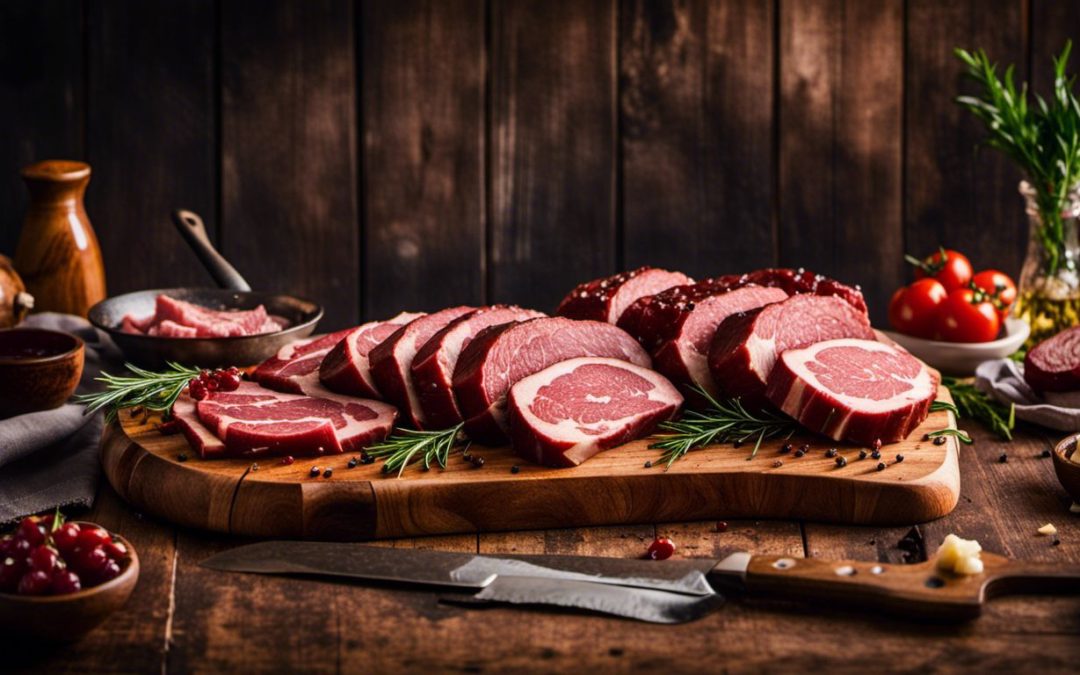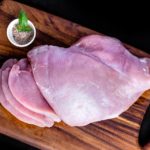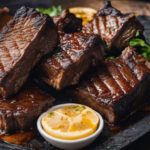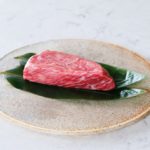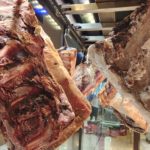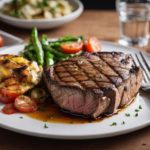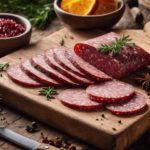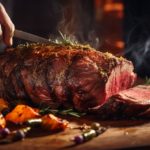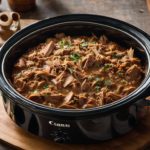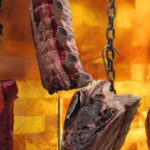Feeling confused at the butcher’s shop when faced with a variety of meat cuts? We’ve been there too, trying to figure out which cut is best for our dinner plan. After extensive research and quest for knowledge, we’ve compiled this guide to help you understand the butcher’s cut, quality meat selection, and how it affects your meals.
Ready to become a pro in selecting the right meats? Let’s dive into it!
Key Takeaways
- Chuck is a versatile and flavorful cut that is perfect for slow cooking or braising.
- The loin offers tender and richly flavored cuts like T-bone and porterhouse steaks.
- The round, flank, short plate, brisket, and shank are all unique cuts of meat with their own distinct flavors and cooking methods.
Primal Cuts and Different Cuts of Meat
The chuck is a primal cut located in the shoulder of the cow, while the loin includes cuts such as the sirloin and short ribs. The round is found in the hind leg, and the flank and short plate are from the belly area.
Lastly, we have the brisket and shank, which come from the front chest and lower leg respectively.
Chuck
Long known for its versatility, chuck is a meat lover’s dream. This cut originates from the shoulder and neck area of the beef animal. Chuck yields hearty flavors that only enhance with slow, moist cooking methods such as stewing or braising.
It provides various individual cuts like roasts, steaks – perfect for pot roast or chuck eye steak – as well as ground meat widely used in burgers and sausages. Marbling, which refers to the fat interspersed within muscle tissues, is richly present in chuck enhancing both taste and tenderness.
As lovers of quality meat ourselves, we find it exciting to explore the many culinary possibilities this beloved butcher’s cut offers!
Loin
The loin is a prime cut of meat that comes from the back of the animal, between the rib and sirloin sections. It’s known for its tenderness and rich flavor, making it highly sought after by meat lovers.
In this guide to quality meat, we want to make sure you understand just how special this cut is. With its fine marbling and minimal connective tissue, the loin offers a melt-in-your-mouth texture that can be enjoyed in various ways.
From juicy steaks like T-bone and porterhouse to succulent pork chops, the loin provides an exceptional dining experience for those who appreciate top-quality cuts of meat.
When it comes to selecting your loin cuts, there are a few factors you should keep in mind. Look for bright red color with creamy white fat running through it – these are signs of a well-raised piece of meat.
The fat should have a firm texture rather than being soft or oily. This indicates good feed quality and proper aging techniques were used during processing.
Round
When it comes to meat, the round cut is an important one to know. It’s taken from the hind leg of the cow and is often leaner than other cuts. The round can be divided into different sections, including top round, bottom round, and eye of round.
Each section has its own characteristics and cooking methods. Top round is a versatile cut that can be used for roasting or slicing thin for sandwiches. Bottom round is great for slow cooking or braising to make tender dishes like pot roast.
Eye of round is lean and best suited for roasts or steak cuts that are cooked quickly at high heat. Understanding the different parts of the round allows you to choose the right cut based on your cooking preferences.
Flank
The flank is a lesser known but flavorful cut of meat that comes from the abdominal area of the cow. It is lean and has a pronounced beefy taste, making it perfect for dishes like stir-fries, fajitas, or even as a marinated steak.
While it may not be as tender as other cuts, proper cooking techniques can help make the flank more tender and juicy. This versatile cut can be sliced thinly against the grain to ensure tenderness.
So next time you’re looking for an affordable and tasty option, give the flank a try!
Short Plate
The short plate is a cut of beef that comes from the belly area of the cow. It is known for its rich marbling and flavorful taste. This cut can be used in various dishes, including braised dishes like short ribs or ground into ground beef for burgers.
The short plate offers a balance of tender meat and delicious fat, making it a favorite among meat lovers who enjoy bold flavors. Whether you slow cook it or grill it, the short plate is sure to satisfy your cravings for quality meat.
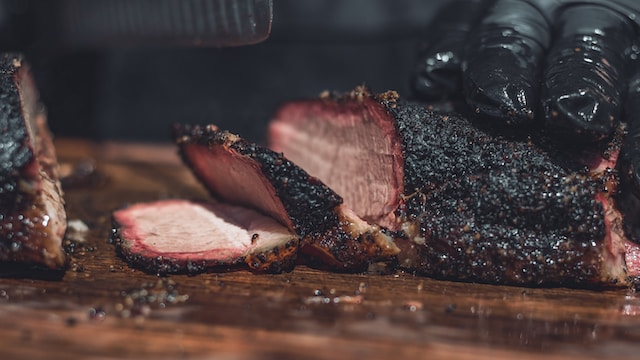
Brisket
Brisket is a flavorful and tender cut of meat that comes from the chest area of the cow. It’s a popular choice for barbecue and slow cooking because it has a good amount of fat, which keeps the meat moist and adds to its rich flavor.
When cooked low and slow, brisket becomes incredibly tender, making it perfect for dishes like Texas-style smoked brisket or traditional Jewish pot roast. To get the best results when cooking brisket, choose one with good marbling, as this will add extra juiciness and flavor to your dish.
Whether you’re smoking it on a grill or braising it in the oven, brisket is sure to be a hit at your next gathering.
Brisket can also be divided into two parts: flat cut and point cut. The flat cut is leaner and more uniform in shape, while the point cut has more marbling throughout. Both cuts are delicious in their own way but require slightly different cooking methods to achieve optimal tenderness.
For example, when smoking or barbecuing brisket, many pitmasters prefer using the whole packer brisket (which includes both cuts) because of its larger size and ability to retain moisture during long cook times.
Shank
The shank is an often overlooked cut of meat that comes from the lower leg of the animal. It may not be the most tender, but it makes up for it in flavor. The shank is known for its rich, beefy taste and gelatinous texture when cooked low and slow.
This cut is perfect for hearty stews, braises, and soups. Just make sure to give it enough time to fully tenderize and develop those delicious flavors. Don’t let this underrated cut go to waste – embrace its unique qualities and create a truly satisfying meal.
Understanding Recommended Beef Cuts
Learn about the 10 primal cuts of a cow and discover the best cuts of meat you should be looking for when buying beef. You won’t want to miss this essential guide to quality meat.
The 10 Primal Cuts of a Cow
Understanding the 10 primal cuts of a cow is essential for any meat lover. These cuts are the main sections of the cow and offer different textures and flavors. Here are the 10 primal cuts:
- Chuck: This cut comes from the shoulder area and is known for its rich, beefy flavor. It’s great for braising or slow cooking.
- Loin: The loin includes the tenderloin and strip steak. It’s one of the most tender cuts and is perfect for grilling or pan-searing.
- Round: The round comes from the rear leg and is leaner in comparison to other cuts. It’s best used for roasting or slicing thin for stir-fries.
- Flank: The flank is a long, flat muscle found on the underside of the cow. It’s great for marinating and grilling or using in dishes like fajitas.
- Short Plate: This cut is found below the rib section and includes short ribs, skirt steak, and hanger steak. It’s full of flavor and benefits from slow cooking or grilling.
- Brisket: The brisket comes from the chest area of the cow and is well-suited for smoking or braising until it becomes tender.
- Shank: The shank is a tough cut found in the lower leg of the cow, often used in stews or soups where long cooking times help break down its toughness.
- Rib: The rib section includes prime rib, ribeye steaks, and back ribs. Known for their tenderness and marbling, these cuts are perfect for grilling or roasting.
- Sirloin: The sirloin sits between the loin and round sections and offers flavorful steaks such as top sirloin and tri-tip roast.
- Short Loin: Finally, we have the short loin, which includes T-bone, porterhouse, and tenderloin steaks. These cuts are prized for their tenderness and are great for grilling or pan-searing.
Front Quarter vs Hindquarter
We’re delving into an interesting aspect of the butchering process – the comparison between front quarter and hindquarter cuts. These sections provide us with different cuts of meat with unique flavors and textures.
| Front Quarter Cuts | Hindquarter Cuts |
|---|---|
| Chuck: This is a relatively tough cut of meat located near the neck and shoulder area. It is ideal for slow cooking, roasting, and stewing. You’ll find cuts like the chuck roast, chuck steak, and ground chuck in this section. | Sirloin: Located between the short loin and round sections, the sirloin delivers some of the most tender cuts of beef. Sirloin steaks are a popular choice for grilling or pan-frying. |
| Brisket: Found in the lower chest or breast of the cow, brisket is known for its rich, deep flavor. It’s a tough cut, making it perfect for slow cooking or smoking. | Round: This cut comes from the rear of the cow and is leaner than other cuts. It’s ideal for roasting or slow cooking to help tenderize the meat. You’ll find cuts like the rump roast and eye round in this section. |
| Shank: Located in the leg portion of the front quarter, the shank is a tough, lean cut. It’s often used in soups and stews for its exceptional flavor. | Short Loin: This is where you’ll find some of the most prized cuts of beef, including the T-bone and Porterhouse steaks. These cuts are tender and well-suited for quick cooking methods like grilling or broiling. |
The front quarter and hindquarter offer different cuts that each have their unique attributes. Understanding these differences helps us select the right cut for our culinary projects, ensuring we get the most flavor and satisfaction from our meat choices.
Best Cuts of Meat From a Cow
We all want the best cuts of meat when it comes to our beef dishes. That perfect combination of tenderness, flavor, and juiciness can make all the difference in a meal. So, what are the best cuts of meat from a cow? Well, let’s start with the prized ribeye steak.
Known for its marbling and rich flavor, it’s a top choice for many meat lovers. Then there’s the tenderloin, also known as filet mignon, which is incredibly tender and lean. And if you’re looking for something with more flavor, try the strip loin or T-bone steak.
These cuts have just the right amount of fat to enhance their taste. Finally, don’t forget about brisket – perfect for slow cooking and barbecue enthusiasts!
Cooking Different Cuts of Meat
We will explore different cooking techniques for each cut of meat, enhancing the flavors and ensuring a delicious meal every time.
Adding Flavor
To enhance the taste of your meat, there are several ways you can add flavor. Marinades are a great option as they not only tenderize the meat but also infuse it with delicious seasonings.
You can create your own marinade using ingredients like vinegar, oil, herbs, and spices, or use store-bought varieties for convenience. Another method is dry rubs which consist of a mixture of spices that you massage onto the meat before cooking.
This creates a flavorful crust that locks in juices and adds depth to the overall taste. For an extra burst of flavor, consider basting your meat with sauces or glazes during the cooking process.
This helps to keep the meat moist while imparting a tangy or sweet element to every bite. Finally, don’t forget about using fresh herbs and aromatics like garlic and ginger to elevate the flavors even further.
Cooking Techniques for Each Cut
Cooking different cuts of meat requires different techniques to bring out the best flavors and textures. Here are some recommended cooking techniques for each cut:
- Chuck: Perfect for slow cooking methods like braising or stewing to break down its tough fibers and create tender, flavorful dishes.
- Loin: Best cooked using high-heat methods such as grilling, broiling, or pan-searing to retain its natural tenderness and juiciness.
- Round: Ideal for roasting or oven-braising at a low temperature to create a tender and juicy result.
- Flank: Great for marinating and grilling quickly over high heat to enhance its natural flavor and tenderness.
- Short Plate: Best prepared by braising or slow-cooking methods to render the fat and enhance the meat’s rich flavor.
- Brisket: Perfect for smoking or slow-roasting at a low temperature to achieve tender, melt-in-your-mouth results.
- Shank: Excellent when cooked using slow-cooking methods like braising or stewing to create fall-off-the-bone tender meat with rich flavors.
Quality Factors and Terminology
– Grass-fed vs Corn-fed Beef: Understand the difference between grass-fed and corn-fed beef, including how it affects the taste, texture, and nutritional value of the meat.
– Ageing Beef (Dry ageing vs Wet ageing): Learn about the different ageing techniques used in meats such as dry aging and wet aging, and how they impact tenderness and flavor.
– Lean vs Fat Meat: Discover the benefits of both lean and fat meat options, as well as tips for selecting cuts based on personal preferences or dietary needs.
Grass-fed vs Corn-fed Beef
Grass-fed beef and corn-fed beef are two common options you’ll find when choosing quality meat. Grass-fed beef comes from cows that have been raised on a diet of grass and forage throughout their lives. This natural diet gives the meat a leaner texture and a more distinct, earthy flavor. On the other hand, corn-fed beef comes from cows that have been fed a diet primarily consisting of corn and grains. This type of feeding generally results in marbling, which adds tenderness and juiciness to the meat. Both types have their own unique qualities, so it really comes down to personal preference when deciding between grass-fed or corn-fed beef.
Although grass-fed beef is often considered healthier because it tends to contain higher levels of omega-3 fatty acids and lower levels of unhealthy fats, some people prefer the richer taste that comes with corn-fed beef. It’s important to note that both grass-fed and corn-fed cattle can be raised using sustainable practices if done responsibly by farmers who prioritize animal welfare.
When selecting your cut of meat, remember that different cuts will vary in tenderness regardless of whether they come from grass or grain-fed cattle. So while it’s good to consider how the cow was raised, also pay attention to factors such as marbling, fat content, age at slaughter (which affects tenderness), cooking method preferences, and what flavors you enjoy most.
Overall, understanding the difference between grassfed and cornfed beef allows you to make an informed decision based on your own preferences for flavor profile, nutritional value or sourcing methods.. Whether you choose juicy marbled steaks from grain-finished cattle or leaner cuts from cows who grazed solely on pasture – both can offer delicious meals!
Ageing Beef (Dry ageing vs Wet ageing)
Ageing beef is a crucial process that enhances its flavor and tenderness. There are two main methods: dry ageing and wet ageing. In dry ageing, the beef is hung in a controlled environment for several weeks to allow natural enzymes to break down the muscle fibers, resulting in more concentrated flavors and increased tenderness.
On the other hand, wet ageing involves vacuum-sealing the meat in plastic to retain moisture while it ages in a refrigerator. This method helps to maintain juiciness but may not develop as much depth of flavor as dry ageing.
Both techniques have their advantages, so it’s up to personal preference when choosing aged beef.
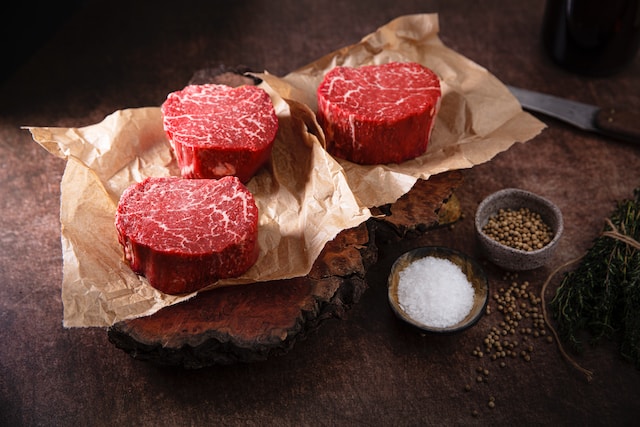
Lean vs Fat Meat
When it comes to choosing meat, understanding the difference between lean and fat cuts is crucial. Lean meat refers to cuts with less visible fat, making them a healthier option. These cuts are typically lower in calories and saturated fats, making them suitable for those watching their weight or following a balanced diet. On the other hand, fatty meats have higher levels of marbling and visible fat throughout. While they may be more flavorful and tender, they are also higher in calories and saturated fats. It’s important to note that some amount of healthy fats is necessary for our body, so finding the right balance between lean and fatty cuts is key.
Conclusion
In conclusion, “Understanding the Butcher’s Cut: A Guide to Quality Meat” is a valuable resource for meat lovers looking to make informed decisions when purchasing and cooking meat.
By understanding the different cuts of meat, recommended cooking techniques, quality factors, and terminology used in the industry, readers can confidently select and prepare high-quality meats that meet their preferences.
Whether you’re grilling a steak or slow-cooking a roast, this guide will ensure you have all the knowledge you need to enjoy delicious and flavorful cuts of meat every time.
FAQs
What is the difference between different cuts of meat?
Different cuts of meat come from different parts of the animal and have varying levels of tenderness, flavor, and fat content. This results in a diverse range of options for cooking and preparation methods.
How can I determine if a cut of meat is high quality?
High-quality meat typically has marbling, which refers to small streaks or specks of fat throughout the muscle tissue. Marbling enhances flavor and tenderness when cooked. Additionally, color, texture, and overall freshness are indicators of quality.
What are some popular cuts of beef?
Popular cuts include ribeye steak, tenderloin filet mignon, New York strip steak, T-bone steak, sirloin steak, and brisket. Each cut offers its own unique characteristics in terms of flavor and tenderness.
How should I cook different cuts of meat?
The optimal cooking method varies depending on the cut you’re working with. For example, tender cuts like filet mignon are best suited for quick cooking methods like grilling or pan-searing to maintain their tenderness. Tougher cuts like brisket benefit from slow-cooking techniques such as braising or smoking to break down collagen and create tender results.
What is quality meat?
A: Quality meat refers to meat that is of high standard in terms of taste, tenderness, and overall freshness.
What does USDA grade mean?
A: USDA grade is a quality indicator used for meat and poultry. It signifies the level of quality based on specific criteria set by the United States Department of Agriculture.
How do I find quality meat from a farm?
A: To find quality meat from a farm, you can visit local farmers’ markets or directly contact farmers in your area. They can provide you with information about the origin and quality of their meat.
What should I consider when buying meat?
A: When buying meat, you should consider the USDA grade, the appearance and firmness of the meat, and any specific package labeling or information that indicates quality.
How can I shop for the best quality meat?
A: To shop for the best quality meat, look for specific quality grades found on packages of meat, ensure that the meat is firm and has a fresh appearance, and use your senses to evaluate the overall quality.
How can I ensure that the meat is safe to consume?
A: To ensure that the meat is safe to consume, check for proper packaging and storage, look for any seals or stamps indicating quality, and follow recommended cooking and handling guidelines.
What are the quality grades for beef?
A: The quality grades for beef include prime, choice, and select. Prime beef is of the highest quality, followed by choice and select.
How can I use my senses to determine meat quality?
A: You can use your senses to determine meat quality by evaluating the appearance, smell, and texture of the meat. Fresh, high-quality meat should have a pleasant odor and appear firm and moist.
What does it mean if the meat is grain-fed or pastured?
A: If the meat is grain-fed, it means that the animal was primarily fed with grain-based food. If the meat is pastured, it means that the animal was raised on pasture and had access to outdoor grazing.
How do I choose the best meat for a specific recipe?
A: When choosing meat for a recipe, consider the cut of meat recommended in the recipe and the cooking method. Different cuts and types of meat are better suited for specific dishes.
Greetings!
With over two decades of diverse experience in the meat industry, I proudly stand as an expert in all things meat. My journey commenced with a strong foundation in hospitality, where I honed my culinary skills as a chef in prestigious restaurants and on luxurious superyachts worldwide.
However, my true passion lies in the art of butchery. Throughout my extensive career, I have had the privilege of working with renowned meat purveyors and mastering the craft of meat cutting and preparation. From breaking down whole carcasses to meticulously selecting prime cuts, my butchery expertise is at the core of my meat knowledge.
Having immersed myself in various cultures and cuisines, I have honed my skills to deliver exceptional dining experiences, crafting delectable dishes that celebrate the natural flavors of different meats. Whether it's sourcing the finest meats for discerning clients or sharing valuable tips on meat selection and cooking, I take pride in elevating the meat experience for both professionals and enthusiasts.
My journey has taken me from the bustling kitchens of top-rated restaurants to the heart of meat processing facilities, gaining insights and honing my skills to become a true meat connoisseur. Now, I am enthusiastic about sharing my expertise, offering valuable insights on meat selection, cooking techniques, and the art of butchery.

